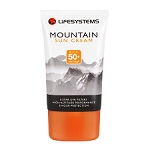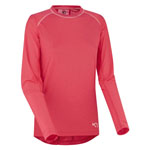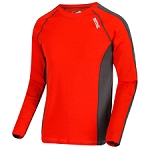It is not something exclusive to summer but, associated with the heat, it is perhaps in this season when we most feel the need to protect ourselves from the sun. In this article we'll explain the dangers of ultraviolet radiation, the different protection factors and how they apply to mountain clothing.

Outdoor activity in sunny weather, precautions must be taken
The sun emits an enormous and varied quantity of electromagnetic waves, some of which we feel in the form of light and heat, while others go unnoticed by us, either because our senses are unable to detect them or because the earth's atmosphere protects us from them. Gamma rays, X-rays, microwaves... the amount of radiation emitted by our star is overwhelming.
The human eye is only able to perceive a very small amount of these electromagnetic waves sent out by the sun, known as the visible spectrum. In other words, the human eye only picks up certain wavelengths that translate into visibility from red (up to 780 nanometres, the longest waves of the human visible spectrum) to violet (380 nanometres, the shortest waves of the human visible spectrum).
Infrared (IR) or ultraviolet (UV) radiation is radiation that exceeds the boundaries of the human visible spectrum. Although this radiation cannot be seen, it affects us directly: we feel heat with infrared radiation and affections to the skin and eyes with ultraviolet radiation. Given the low energy of infrared radiation, it is harmless to humans.

In our outdoor activities we receive infrared radiation (harmless) and ultraviolet radiation (harmful).
Types of Ultraviolet Light
Within the ultraviolet radiation that reaches the earth's surface, there are two subtypes, depending on the wavelength: UVA rays and UVB rays. The more harmful UVC rays are blocked by the atmosphere. The difference in our interests lies in their penetration capacity and their effects on the human body.
UVA rays account for 95% of the ultraviolet radiation reaching the earth and their strength is constant during all daylight hours every day of the year. They have the ability to penetrate clouds and glass and penetrate deep into the skin which, in response to the damage, activates the production of melanin that causes tanning.
UVB rays penetrate and damage the outermost layers of the skin. They do not penetrate glass or large clouds. Their danger is normally concentrated in the central hours of the day between spring and autumn, although it is in our interest to point out that in high mountains they are dangerous all year round, especially when reflected by snow and ice. In addition to tanning, overexposure to them causes sunburn and even blisters.

High mountain sunshine with snow. Dangerous UVB is very present here.
Damage From Ultraviolet Light
On the one hand, we have beneficial effects such as the synthesis of vitamin D caused by UVB rays. Vitamin D improves the immune system and promotes the absorption of calcium which keeps our bone structure strong.
On the other hand, exposure to ultraviolet rays is harmful. We have already discussed the short-term skin damage from UVA and UVB rays.
In the long term, shortwave UV damages the DNA of skin cells, causing premature ageing at best and genetic defects or mutations that lead to skin cancer. Burns, carcinomas, melanomas... the list of effects of ultraviolet radiation on the skin is dramatic. In the case of the eyes, macular degeneration and cataracts are also closely associated with overexposure to ultraviolet radiation.
Sun protection factors
There are two common methods of measuring sun protection that are used both in the cosmetics industry (creams and lip balms) and in the textile industry. These two methods are SPF (Sun Protection Factor) and UPF (Ultraviolet Protection Factor), where SPF is usually applied to creams and lotions and UPF to materials.

Activities by the sea and on snow require extra protection.
They are two complementary methods but with notable differences between them that need to be explained.
Sun Protection Factor (SPF)
It is indicated by a number that indicates the level of protection of that product against sunburn. SPF only measures damage from UVB rays, which affect the outermost layers of the skin.
We usually find it in SPF30, SPF50, SPF50+... and this factor is the result of dividing the time it takes for protected skin to redden slightly compared to unprotected skin.
In other words, if a piece of unprotected skin takes 5 minutes to redden slightly in the sun but protected with a cream it takes 150 minutes to reach the same level of redness, its SPF will be 150/5= 30. In other words, a SPF30 offers 30 times more protection than the skin would have without such protection.
In Europe, the protection study is carried out using the COLIPA method (European Cosmetic Association). For this, there is a concept which is the minimum erythema dose which means the first visible reddening of the skin. It is performed in a standardised way so that the results are the same regardless of the laboratory investigating it: 2mg/cm² on 35 cm² of skin on the back for 15 minutes.

In conditions of high UV exposure such as in the mountains, it is advisable to combine SPF creams an
SPF 30+ is considered to be good enough protection, while SPF 50+ is considered to be excellent. Since the differences in protection between, for example, SPF60 and SPF100 are minimal (98.4 and 99%, respectively), there is an agreement that the highest protection factor indicated in the SPF is 50+, with the higher nomenclature being permitted only in special protection products such as those used for oncology patients.
Ultraviolet Protection Factor (UPF)
It indicates the proportion of ultraviolet rays, both UVA and UVB, that are able to pass through a fabric. A UPF30 would indicate that this material would only let through a proportion of 1 out of every 30 UV rays (3.33%) and a UPF50 would let through 1 out of every 50 UV rays (2%).
Just as a visual assessment of the appearance of sunburn is useful for SPF, a spectrophotometer is required for UPF, and it may be the brands themselves or independent certification laboratories, which we will talk about later, which are responsible for indicating the result obtained by the garment.

Patagonia Quandary Shorts with UPF50+ protection
There are several factors that determine the level of UV protection of a garment:
- Material: The composition of a fabric is a determining factor in its level of UV blocking. Synthetic fibres (polyamide, polyester, elastane, etc.) provide better protection from UV radiation than natural fabrics (cotton, linen, silk, etc.).
- Fabric weave and thickness: A dense weave is more protective against UV rays than a finely woven fabric. The density of the garment as well as its thickness increases the amount of UV radiation blocked. Similarly, a material that shrinks with washing will be more protective the more it is washed as the weave of the garment decreases.
- Colour: the darker a fabric is, the more UV radiation it will absorb; this also works with bright colours. White and light colours tend to reflect quite a lot of UV rays. In the case of dyed fabrics, moreover, the dye molecules tend to block the holes in the weave more.
- Elasticity: A tight-fitting stretch fabric allows UV radiation to pass through better than a loose-fitting fabric.
- Humidity: humidity present in a fabric due to perspiration or water has a very negative effect on the UV protection it offers as it becomes more transparent.
- Condition of the garment: the older a garment is (wear and tear, holes, etc.) the lower the protection against UV radiation.
Obviously, the ultraviolet protection of a garment is limited to the areas of the body it covers, and therefore more protective garments have more fabric surface area, such as long-sleeved T-shirts and even hooded jackets.

Borealis pull-on de Rab. UPF 50+ jacket
In addition to the physical characteristics of the garment, some manufacturers incorporate specific elements such as titanium dioxide, also used in sun protection creams due to its capacity to block the absorption of ultraviolet light and which, unlike these, remains in the garment throughout its useful life.
UV Standard 801 and EN 13758
In view of this, we can see that certain values of a synthetic mountain garment such as material, construction and quality help us to protect ourselves adequately from the sun. The usual resistance of mountain clothing, associated with the weave, the grammage and the choice of material, contributes to prevent ultraviolet radiation from reaching our skin, thanks to its tight weave and breathability.
It seems that we have to rely on our interpretation of a fabric's characteristics to know if it will protect us from ultraviolet exposure. But are there objective tests to determine the ultraviolet protection of a garment? Fortunately, yes.
There are different standards that determine the UV protection factor of a garment. Used extensively in swimwear and sun umbrellas for obvious reasons, they are increasingly being implemented in our mountain clothing.
In addition to those applied in Australia and the USA outside our area, there is the European standard EN 13758 and the stricter UV Standard 801 of international application, which takes into account a more harmful solar spectrum and analyses garments under conditions of stretching and wear. Both standards are not compulsory, although it is recommended that all outdoor garments indicate the level of UV protection they achieve, and the fact that they are endorsed by certification laboratories is an additional element to be taken into account.

Logos of the sun protection regulations
Advantages of Wearing UPF Technical Clothing in Summer
It is obvious that in conditions of intense activity with high temperatures we will not be able to bear wearing long trousers and long-sleeved shirts. If we want total protection, we will have to adapt the hours we go out to times of less sunshine or use sun protection creams. A hat without mesh fabric is another basic accessory for sun protection.

The North Face Horizon Ball cap. UPF50+ protection
However, the technical mountain clothing used for summer, apart from the aforementioned characteristics, allows certain advantages over non-technical clothing such as cotton T-shirts or similar. These are:
- Unlike creams and lotions, they do not lose their effectiveness with time or sweat, and they don't rub off..
- The material usually used, polyester, largely blocks the passage of UV radiation..
- It dries very quickly, which is beneficial in UV protection.
- Depending on the activity, the weave is dense to resist the usual rubbing of exercise and abrasion from other elements such as backpacks and other garments.
In addition to all this, the garments you will find at Barrabes - and here we avoid false modesty - have a superb and proven quality. A garment that doesn't wear out easily is guaranteed to provide long-lasting protection for much longer.
We invite you to take a look around our website or visit our shops to discover our range of UPF-protected clothing to face the mountain sun with all the guarantees.

















Leave a comment
Be the first to comment on this article.